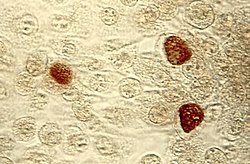Chlamydiae
| Klamidia
| |
|---|---|
| Chlamydiae | |
| Taksonomi | |
| Superdomain | Biota |
| Domain | Bacteria |
| Subkerajaan | Negibacteria |
| Filum | Chlamydiae |
| Tata nama | |
| Sinonim takson |
|
| Ordo dan famili | |
Chlamydiae adalah filum bakteri yang secara alami ditemukan hidup hanya di dalam sel hewan (termasuk manusia), serangga, dan protozoa.
Pada 1966, Chlamydiae dikenal sebagai bakteri dan genus Chlamydia disahkan (Moulder,1966; Page 1966). Ordo Chlamydiales dibuat oleh Storz dan Page pada 1971. Antara 1989 dan 1999, suku baru, genera dan spesies dikenal. Filum Chlamydiae established dalam Bergey's Manual of Systematic Bacteriology (Second Edition Release 1.0, April 2001). Pada 2006, data genetis untuk lebih dari 350 lineage Chlamydia dilaporkan.([1]), empat suku chlamydial dikenal (Chlamydiaceae, Parachlamydiaceae, Simkaniaceae, and Waddliaceae), dan suku lain diajukan (Rhabdochlamydiaceae) (Everett et al., 1999; Rurangirwa et al., 1999; Corsaro et al, 2006).
Chlamydia parasit juga endosimbion, tergantung inang eukariotik dan spesies chlamydial.
Ada tiga spesies utama chlamydiae yang menginfeksi manusia:
- Chlamydia trachomatis, yang menyebabkan penyakit mata trakoma dan penyakit menular seksual chlamydia;
- Chlamydophila pneumoniae, yang menyebabkan pneumonia;
- Chlamydophila psittaci, yang menyebabkan psittacosis.
Bacaan lanjutan[sunting | sunting sumber]
- Dautry-Varsat A, Subtil A, Hackstadt T. 2005. Recent insights into the mechanisms of Chlamydia entry. Cell Microbiol. 7: 1714-1722.
- Everett KDE, Bush RM, and Andersen AA. 1999. Emended description of the order Chlamydiales, proposal of Parachlamydiaceae fam. nov. and Simkaniaceae fam. nov., each containing one monotypic genus, revised taxonomy of the family Chlamydiaceae, including a new genus and five new species, and standards for the identification of organisms. Int J Syst Bacteriol. 49:415-440.
- Corsaro D, and Greub G. 2006. Pathogenic potential of novel Chlamydiae and diagnostic approaches to infections due to these obligate intracellular bacteria. Clin Microbiol Rev. 19:283-297.
- Corsaro D, Thomas V, Goy G, Venditti D, Radek R, and Greub G. 2006. Rhabdochlamydia crassificans, sp. nov., comb. nov., an intracellular bacterial pathogen of the cockroach Blatta orientalis (Insecta: Blattodea), and proposal for Rhabdochlamydiaceae, fam. nov., a new family of Chlamydiae infecting arthropods. Syst Appl Microbiol. Apr 16; [in revision]
- Greub G, and D Raoult. 2003. History of the ADP/ATP-translocase-encoding gene, a parasitism gene transferred from a Chlamydiales ancestor to plants 1 billion years ago. Appl Environ Microbiol. 69:5530-5535.
- Horn M, Collingro A, Schmitz-Esser S, Beier CL, Purkhold U, Fartmann B, Brandt P, Nyakatura GJ, Droege M, Frishman D, Rattei T, Mewes HW, and Wagner M. 2004. Illuminating the evolutionary history of chlamydiae. Science. 304:728-730.
- McCoy AJ, and Maurelli AT. 2006. Building the invisible wall: updating the chlamydial peptidoglycan anomaly. Trends Microbiol. 14:70-77.
- Rurangirwa FR, Dilbeck PM, Crawford TB, McGuire TC, and McElwain TF. 1999. Analysis of the 16S rRNA gene of micro_organism WSU 86_1044 from an aborted bovine foetus reveals that it is a member of the order Chlamydiales: proposal of Waddliaceae fam. nov., Waddlia chondrophila, gen. nov., sp. nov. Int J Syst Bacteriol. 49:577-581.
- Taxonomic Outline of the Procaryotes, Bergey's Manual of Systematic Bacteriology, Second Edition Release 1.0, April 2001 ( [2][pranala nonaktif permanen])
- Teeling H, Lombardot T, Bauer M, Ludwig W, and Glöckner FO. 2004. Evaluation of the phylogenetic position of the planctomycete ‘Rhodopirellula baltica’ SH 1 by means of concatenated ribosomal protein sequences, DNA-directed RNA polymerase subunit sequences and whole genome trees. Int J Syst Evol Microbiol. 54:791-801.
- Ward NL, FA Rainey, BP Hedlund, JT Staley, W Ludwig, and E Stackebrandt. 2000. Comparative phylogenetic analyses of members of the order Planctomycetales and the division Verrucomicrobia: 23S rRNA gene sequence analysis supports the 16S rRNA gene sequence-derived phylogeny. Int J Syst Evol Microbiol. 50:1965-1972.

